Types of mixtures by purpose
All mixtures for leveling the floor are divided into two large groups:
- for initial (rough) processing;
- for finishing.
They differ from each other in composition, structure and performance.
Rough equalizers
For roughing operations involving the elimination of deep chips, cracks and gouges, leveling out large differences in height, a rough floor leveler is used.
Application features:
- This type of leveler is a dry mix of coarse particles. To prepare the working solution, you need ordinary clean water.
- The floor leveler can be applied to concrete, cement or brick substrates, spreading from 5 mm to 7 cm thick in one layer.
- The consumption of an aqueous solution of a coarse leveling agent is from 2 to 5 kg per square meter. with a thickness of 1 mm.
- Due to the large particles in the composition, this type of self-leveling floors cannot form a perfectly smooth surface and requires further refinement.
Finishing level-masses
The finishing leveler for the floor consists of smaller particles. It can be applied to precoated surfaces or directly to the substrate, provided it is slightly defective.
Application features:
- The solution turns out to be homogeneous and plastic, it fills in all small irregularities, and upon drying it forms an impeccably even and smooth surface on which any floor covering can be laid.
- The consumption of the finished solution will be 1.5–1.7 kg per square meter. with a thickness of 1 mm.
- Finishing compounds are marketed as self-leveling floor compounds.
Most popular manufacturers
There are such popular formulations:
Mix "Vetonit"
"Vetonit". This agent is significantly better than conventional concrete screed. It is necessary to highlight such a substance as "Vetonit-plus". Most often, it is chosen by professionals, since the composition freezes very quickly. Please note that this product cannot be used as a topcoat. Besides, it is not recommended to paint "Vetonit" either.
Mix "Knauf"
Knauf. The presented solution is used quite often. Its characteristics ensure the relevance of the material. Knauf Baden mortar, which includes high quality gypsum, is very popular on the market. In addition, quartz sand can be added to the product for better adhesion to the substrate. Modified additives make the Knauf composition easy to use and of very high quality.
Mixture "Ceresit"
"Ceresit". This self-leveling compound can be used on concrete and sandy substrates. After pouring such a solution, you can use wood, tiles, linoleum, and even carpet as flooring.
I would like to say separately about the self-leveling floor "Hercules". This mixture is versatile, dries quickly, and has positive reviews. For example, the mortar spreads well and provides a perfectly flat surface. The only drawback can be considered that it needs to be made more liquid than written in the manufacturer's instructions.
Varieties of peers
All such mixtures are conventionally classified into two large groups used for leveling:
- draft;
- finish.
The structure of these materials is different, respectively, they differ in their properties.
Each manufacturer adheres to its own production technology, using various components of the mixture. For example, gypsum or cement is used as the base material for a coarse leveling agent, which determine the performance characteristics of the product:
- gypsum compositions are not recommended for use in wet rooms;
- in cement - its brand plays a decisive role, for example, the use of M600 makes it possible to obtain a high-strength material. Even its thin layer is able to withstand quite heavy loads.
Rough leveler
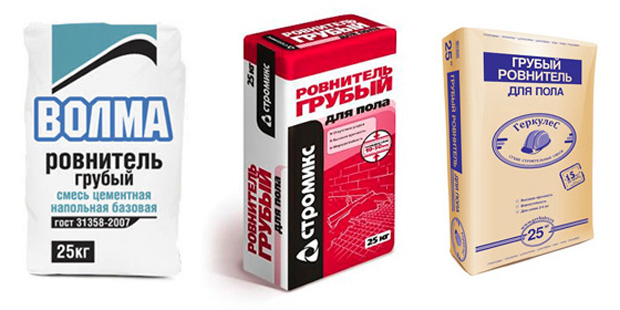
This material is intended for concrete foundations with sufficiently large defects such as height differences, deep chips, cracks, potholes. These are dry formulations containing coarse particles. Most often, cement is used as a base component. It is he who is able to provide the required strength and adhesion to the base surface.
The thickness of the applied layer of the finished mixture can be quite large, which makes it possible to hide the difference in heights on the plane of the base, although this does not prevent it from remaining resistant to heavy loads without cracking. Of course, all this with the right choice of leveling material.
A large assortment of goods of this type from different manufacturers is presented on the building materials market. Instructions for their use, as a rule, are indicated on the packaging. The maximum permissible thickness of the leveling layer is also indicated there.Suppose the thickness offered by the manufacturer should not be more than 1 cm. If the laid layer turns out to be thicker, then it will not be sufficiently resistant to stress and will crack.
Appointment
Certain brands of this type of goods are used when:
- laying the leveling screed on a solid and solid foundation such as concrete, brick, stone, cement, on which the final floor will be laid in the future;
- the device of the base under the warm floor;
- arrangement of a floor with a slope, as when pouring an inclined base;
- laying a floating screed;
- the leveling agent can also serve as a final layer, which will later be painted with a special paint for concrete.
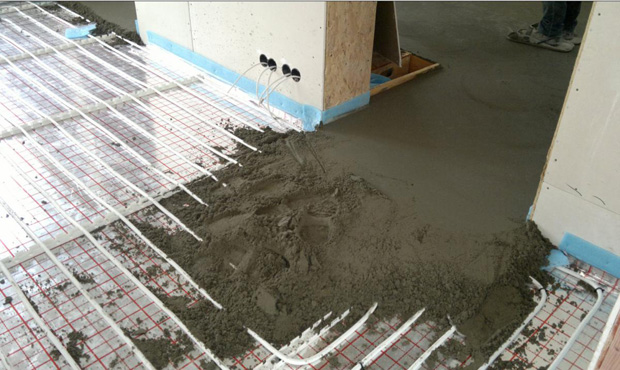
- Rough floor screeds are laid in one layer.
- If there are damages on the concrete base, the depth of which is more than 1 cm, they must first be repaired using the same composition. Then proceed to laying a monolithic layer of the mixture.
- With all your efforts, it is impossible to guarantee a smooth surface of the base, only pouring this solution containing coarse-grained components. This is why another layer of finishing material is required.
Finishing leveler
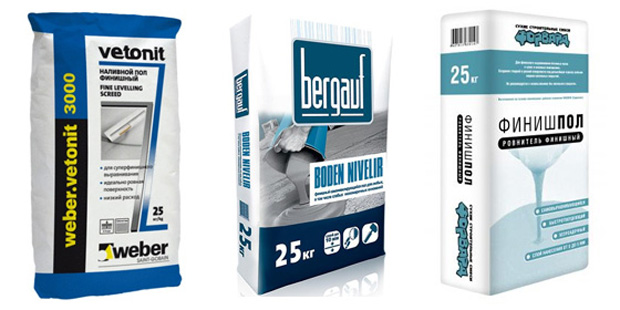
This species contains fine fractions. When added with water, they form a more homogeneous mass that can be easily applied to the surface. The result is a smooth screed. There are higher demands on the finish equalizers, both for their practical use and aesthetics.
Self-leveling floors are very popular. To use them, you do not need special knowledge and skills - the composition, spreading over the surface, aligns the base horizontally. Self-leveling floors are widely used in cosmetic repairs, since the mixture fills in minor damage and effectively hides small drops. This eliminates the need to fill the coarse leveling compound, which saves you time and money.
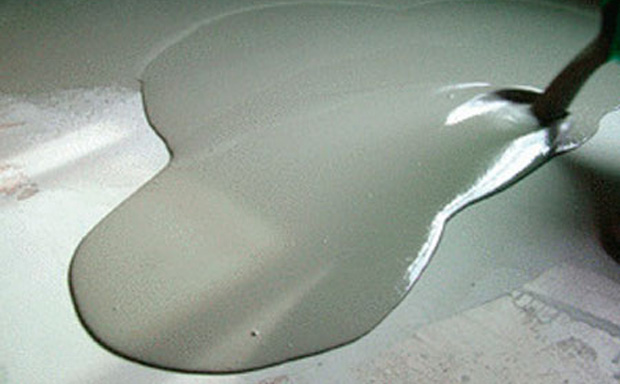
Finishers have a lot of advantages. For example, they
- durable;
- elastic;
- resistant to mechanical stress.
However, to improve the performance of the material, they include various components from polymers or minerals.
Self-leveling floor leveler which is better? A question asked by many real estate owners planning renovations or capital construction of a house, a cottage.
The perfectly flat base of the floor guarantees stability and durability of the finish floor covering. The need to obtain a flat floor arises at the time of removing the old floor, planning to eliminate all the disadvantages of previous irregularities. The modern construction market offers many screed technologies, filled with mixtures that differ in cost and purpose.
Floor mixtures are divided into 2 groups:
- For rough fill;
- Finishing pouring of the main coating;
Popular formulations
When choosing a suitable self-leveling mixture, pay attention to formulations that are highly popular with users. The increased demand for such materials is dictated by their high performance characteristics.
For finishing to cover
Such formulations allow you to level the base before laying the floor covering. They make it possible to form a layer of different thickness depending on the existing defects.
Thick self-leveling floor "Prospectors": rating 8/10
Self-leveling cement-based mixture. It is used for leveling cement screed, concrete base in the presence of large differences in height. Suitable for all types of premises. Allows to form a high-quality layer with a thickness of 30–100 mm. Allows work at temperatures from + 5 ° C to + 30 ° C. The solution is viable for 40 minutes. Consumption: 1.7 kg per 1 m².
Universal mixture "Osnovit Skorline FK45 R": rating 10/10
Universal dry self-leveling mortar based on cement for interior use. Suitable for foot traffic two hours after pouring. The thickness of the formed layer is from 2 to 100 mm. Consumption 1.3 kg / m². Can be used with warm floors. Packaged in 20 kg. The solution is viable within 40 minutes.
Basis Skorline FK45 R - a composition that is relevant for any room Universal mixture "Osnovit Skorline FK45 R"
For uncoated floors
Self-leveling floor often acts as the main coating. In warehouses, industrial facilities, it is inappropriate to lay decorative coatings. The formed layer has sufficient strength and is not afraid of the effects of reagents.
High-quality coating is an important condition for the safe work of employees
Industrial bulk floor "Glims Heavy Duty (A + B)"
A fast-hardening, non-shrinking two-component compound that allows the formation of a high-strength coating with a thickness of 5 to 12 mm. Allows manual and mechanized application. Used in industrial facilities, garages, warehouses. Maximum filler fraction 0.6 mm. Consumption 2 kg / m². The solution is viable for 20 to 25 minutes.
Polyurethane self-leveling floor GRASPOLIMER PU20-SLF
Two-component composition. Does not contain organic solvents. Allows tinting. Produced in small containers of 5 kg and large containers of 30 kg. Should be stored in a dark place. Consumption 1.5 kg / m². The solution is viable for half an hour. The shelf life is six months.
GRASPOLIMER PU20-SLF with self-leveling effect Polyurethane self-leveling floor GRASPOLIMER PU20-SLF
For decorative finishing
A self-leveling floor is often used to form a beautiful decorative floor covering. It becomes one of the main elements of the interior, withstanding a significant operational load.
Self-leveling floor "Paint Polymerstone-2 RAL 7040"
Elastic, abrasion-resistant composition. Differs in chemical resistance. Does not contain solvents. Consumption 1.5 kg / m². The solution is viable within 40 minutes. The guaranteed shelf life is six months.
Self-leveling floor "Paint Polymerstone-2 RAL 7040" - a self-leveling mixture for any room Self-leveling floor "Krasko Polymerstone-2 RAL 7040" Krups EA8010PE
Colored epoxy self-leveling floor Remmers Epoxy OS Color
A high-quality, universal-purpose composition based on epoxy resin. Allows styling at temperatures from + 10 ° C to + 30 ° C. Allows to form a layer with a thickness of 2 - 5 mm. Tinted. The solution is viable within 25 minutes. The hardening time is 24 hours. Consumption 1.6 kg / m².
Colored epoxy self-leveling floor Remmers Epoxy OS Color Colored epoxy self-leveling floor Remmers Epoxy OS Color
Device technology
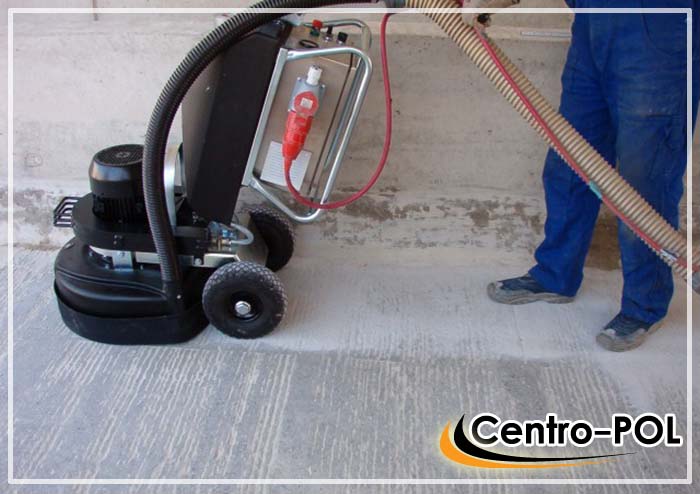
Now it's worth figuring out how to properly level the floors with self-leveling mixtures. To do this, you need to go through three main stages:
- Preparation of the base. Before pouring the solution, the base must be prepared;
- Dilution of the solution. A very important stage, if you do not observe all the necessary proportions, the coating may very soon become unusable;
- Pouring the mixture. Direct application of the mixture to the floor surface.
Preparation
Before leveling the floors with a self-leveling mixture, you should perform the following actions:
- Removing the old coating. The base must be completely cleaned of obsolete flooring;
- Then the floor is cleaned of debris and a primer is applied. The primer improves the adhesion of the concrete base and mortar;
- If after drying you see that the surface remains loose, prime it again. In this case, you cannot be lazy, otherwise the repair will go down the drain.
Dilution of the solution
- The manufacturer of the mixtures must indicate on the packaging how much water needs to be added in order to obtain the composition of the desired consistency. Observe all the data very clearly, otherwise your self-leveling floor for outdoor use will have insufficient plasticity and ductility. As a result, the coating will turn out to be of poor quality;
- Pour the required amount of water into a previously prepared container;
- Then gradually add to its dry mixture, stirring the contents. In such a situation, you will get a homogeneous composition;
- The package must indicate the setting time of the emulsion. You must use the mortar according to the allotted time, since you cannot re-add water to the leveler.
The video shows the correct breeding technology for such compounds.
Laying the mixture
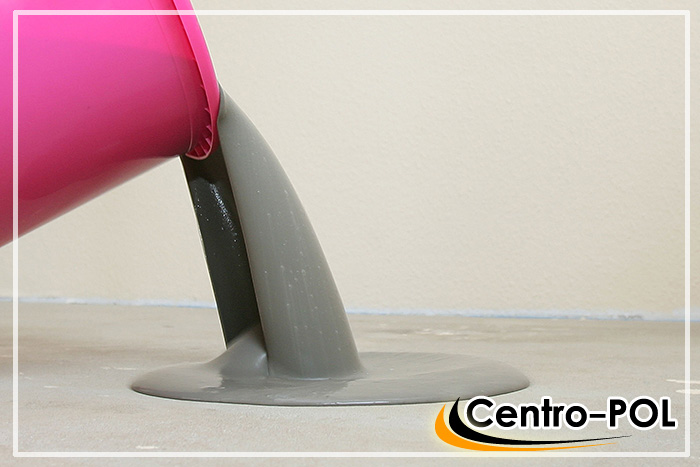
It is necessary to lay the solution within 3 to 24 hours after the base is primed.
- Find the highest point on the base of the floor and place a beacon there;
- After that, mount the beacons around the entire perimeter of the room. This will make it easier for you to control the thickness of the mixture;
- Pour the solution in small portions, no more than 1 square meter;
- Using a self-leveling roller, spread the compound over the entire surface. The layer thickness should not be less than 5 cm;
- To prevent bubbles from forming in the solution, go over the surface with a needle roller;
- If it is necessary to apply an additional layer, do the work within 10 minutes, otherwise the composition will begin to thicken;
- Depending on the temperature and humidity level in the room, the surface will harden in 3-14 days.
This is how self-leveling floor mixes are placed, the video demonstrates the application process in detail. It will be nice if you hire someone as an assistant to carry out the work. If you've never experienced anything like this before, it won't be easy for you to fill it alone.
The strength of a self-leveling floor covering exceeds that of even cement screeds. Therefore, this type of mortar has become so popular in private construction. Depending on the conditions in the room (temperature, humidity, load on the coating), the consumer can purchase formulations with different technical characteristics.
Some levelers have a high level of strength, others are not afraid of temperature extremes, and others dry quickly. If you want your coating to last long, be sure to follow the instructions on the package. After all, only a solution with the correct proportions will ensure the quality and reliability of the coating.
General tips for use
Mixes for leveling the floor allow you to complete construction work in a very short time, but at the same time require very careful compliance with the instructions
Therefore, before using them, or better before buying, it is recommended to always familiarize yourself with the manufacturer's recommendations and pay attention to the purpose of the solution, as well as its compliance with the room. After that, you can make a choice.
Always determine the right amount of material before use.
Practice shows that to create a one-millimeter screed on one square meter of a wooden floor, on average, almost a liter of mortar is needed.
Further calculation consists in calculating the area of the room and determining the thickness of the layer in demand. Further, all numbers are multiplied. This is how they determine how much you need to stock up with a self-leveling mixture.
All work should be carried out in a room with closed doors and windows. The main thing is that there are no drafts.
Operation at other temperatures is undesirable. If it is cold, then self-leveling mixtures will not be able to provide the proper strength of the floor, since water will be released too slowly and the formed excess will destroy the polymers. High temperature operation will result in premature evaporation of water. The solution will not have time to spread normally on the surface
The creators of various videos often talk about this.
It is also important to maintain the correct humidity level. Often its value should be 50-65 percent.
You need to use those solutions, the expiration date of which has not ended.
Another important condition is the presence of assistants
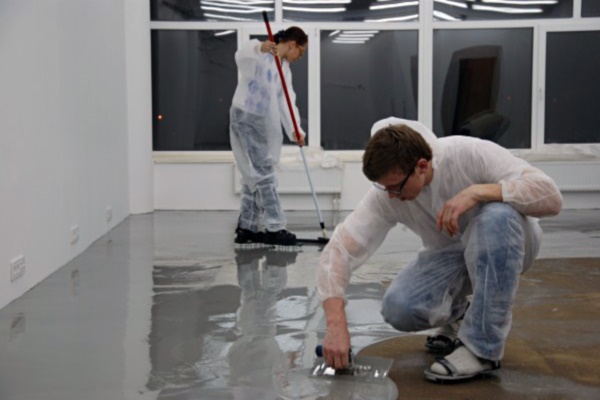 The condition is the presence of assistants
The condition is the presence of assistants
It should be understood that the work must be organized so that during the pouring of the last sections, the first row is still liquid. This means that kneading, pouring, as well as smoothing the solution should take up to 15-40 minutes (the time depends on the characteristics of the product). It is impossible to keep within this time without assistants. One person should prepare the solution, another person should pour and spread it.
You can speed up the work using an automatic mixer and a pump that delivers the solution.
Views
All materials for self-leveling floors are divided into two large subgroups:
The first group is made on the basis of cement. This material can be used both in the bathroom and in the living room, as well as in rooms with any indicators of humidity. The thickness of the cement layer is allowed from 2 to 5 cm. Such floors are more expensive than gypsum, but stronger and more durable. The dry mixture is diluted with water according to the instructions.
There are also special leveling agents with polymerizing binders.
Epoxy-polyurethane self-leveling compounds have the properties of both epoxy and polyurethane floors. This material works great under extreme loads, for example, in the subway, at train stations, at airports.
Cement-acrylic floors are suitable for swimming pools, saunas, corridors, halls due to their rough surface. These mixes contain acrylic.
Fast hardening floors, methyl methacrylate. Such a floor is applied in a layer of any thickness, it very quickly gains the design strength and dries out. This material is indispensable when you need to do everything very quickly and smoothly. When pouring, it smells very harsh, but the smell quickly disappears.
Repairing compound for wood floors. This solution contains a special additive in the form of fibers, which adheres perfectly to the wooden base.
Transparent polymer floors, consisting of polymer and hardener. The liquid solution is poured onto a perfectly even plaster and putty base. Patterned floors are installed in two layers, the top layer is transparent. A three-dimensional banner film, shells, colored sand and other decorative elements are laid between the layers.
These floors look amazing and are used as a topcoat in homes, apartments, hotels, restaurants, art galleries - wherever interesting and original flooring is needed. This is a real decoration for any interior.
Depending on the grain size of the additives, leveling compounds are divided into rough and finishing:
- Coarse mixtures contain components of larger fractions, such as sand, crushed stone, crushed granite, expanded clay. Therefore, the surface of the layer is uneven.The high density prevents the solution from spreading over the surface, because of this, it must be leveled with a rule. Such dopants are used to fill chips, holes, height differences, deep cracks in rough foundations. The permissible fill thickness varies from 1 to 8 cm.
- Finishing compounds have a thinner structure, have significant fluidity and plasticity. The finishing layer is thinner, it evens out only minor differences in height, it perfectly penetrates into all cracks and voids. The surface of such a floor after hardening becomes absolutely smooth and even.
How to mix leveling compounds correctly
How to mix leveling compounds correctly
If the mixture is diluted incorrectly, no tricks will help to make a high-quality coating. The main mistake of novice craftsmen is adding more water than indicated in the instructions. A more liquid composition spreads faster, but the strength and durability of the floor is reduced several times. In addition, delamination, cracks, and other defects may appear on the coating.
To properly prepare the solution, you will need water with a temperature of at least + 10 degrees, a convenient kneading container, a drill with a nozzle and a dry mixture. Strictly adhering to the indicated proportions, the mixture is poured into water and stirred for 3-4 minutes with a mixer nozzle. Then leave the solution to ripen for 3 minutes and mix again for a minute. You should get a homogeneous mass without lumps, liquid enough to spread without additional leveling. If the technology is observed, the pouring process will not cause difficulties, and the mixture consumption will not exceed the calculated one.
| Name | Curing time | Layer thickness | Consumption kg / m2 | Price RUB / kg |
|---|---|---|---|---|
| Horizon universal | 3-7 days | 2-100 mm | 3-4 | 236/20 |
| BOLARS | 4 hours | 2-100 mm | 3-4 | 239/20 |
| Vetonit 3000 | 4 hours | 1-5 mm | 1,5 | 622/25 |
| Palafloor-303 | 4-6 hours | 2-100 mm | 1,4-1,6 | 308/20 |
| GLIMS-S-Level | 24 hours | 2-5 mm | 3 | 478/20 |
| Perfekta Multi-layer | 2-3 hours | 2-200 mm | 7-14 | 312/20 |
| xton | 3-4 hours | 6-100 mm | 14-16 | 256/20 |
| Name. Short description | Packing kg | Consumption kg / mm / m2 | Price | Strength MPa | Layer thickness in mm |
|---|---|---|---|---|---|
| ALFAPOL VP - self-leveling self-leveling self-leveling flooring М200 F200 Рк5 W12 on a cement basis | 25 | 1,75 | 375-471 | 20 | 2-40 |
| REAL Floor leveler, High quality dry mortar, cement-based | 25 | 1,7 | 360 | 20 | 2-80 |
| Bergauf BODEN ZEMENT MEDIUM, self-leveling floor for the final leveling of horizontal surfaces, ideal for the further laying of any floor coverings (ceramic tiles, parquet, carpet, linoleum) | 25 | 2 | 289-324 | 20 | 6-60 |
| Forbo Eurobond 915, a fast-curing self-leveling floor with low shrinkage, self-leveling, quick-drying. Suitable for heated floors. For indoor use incl. in damp rooms. Withstands the load of furniture on casters. | 25 | 1,7 | 405 | 20 | 3-50 |
| Petromix PS, for leveling floors on concrete and other hard substrates in dry, damp and damp rooms. Serves as a base for floor coverings (parquet, ceramic tiles, textile carpets, plastic coverings, linoleum, etc.) | 25 | 1,5 | 441-471 | 25 | 2-30 |
| Osnovit T-42 Nipline, Self-leveling, high-strength, moisture-resistant, non-shrinking leveling agent on a cement-sand base with the use of special chemical additives. | 25 | 1,7 | 342-433 | 25 | 3-30 |
| Ceresit CN 178, for the manufacture of screeds operating under low and moderate mechanical loads, incl. with constant exposure to moisture (in residential and public premises, on operated roofs, balconies, terraces, open areas, etc.), during external and internal work, in civil and industrial construction. | 25 | 2 | 370 | 35 | 5-80 |
| Vetonit 4100 cement-based mix for leveling concrete floors indoors | 25 | 1,6 | 520-537 | 20 | 2-30 |
| vetonit 4150, suitable for quick leveling of concrete floors and screeds in homes, offices and public buildings. It is used for renovation and new construction under various types of floor coverings. Used in constructions "Warm floor" | 25 | 1,6 | 520-550 | 20 | 2-30 |
| Bergauf BODEN ZEMENT FINAL, cement-based self-leveling floor for perfectly smooth surfaces. For rooms with normal and high humidity (bathroom). | 25 | 1,8 | 435-490 | 20 | 0,5-5 |
Knauf and other brands
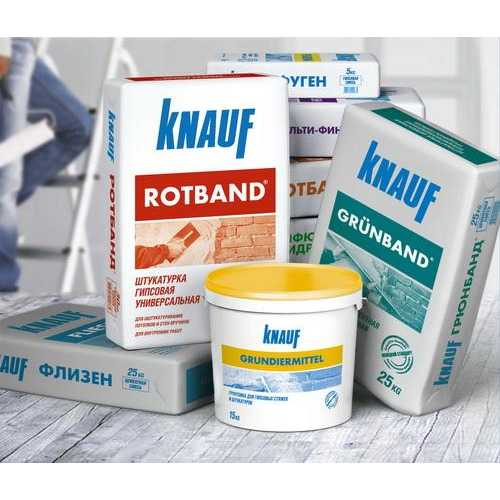 Choosing today floor levels, it is difficult not to get lost in the abundance of manufacturers. Nevertheless, there are a number of offers on the market that are consistently in consumer demand. Among them are self-leveling floor mixes Knauf. In the assortment of this company there are several similar proposals, among which the Knauf-Boden series stands out. This series contains mixtures based on high-strength gypsum.
Choosing today floor levels, it is difficult not to get lost in the abundance of manufacturers. Nevertheless, there are a number of offers on the market that are consistently in consumer demand. Among them are self-leveling floor mixes Knauf. In the assortment of this company there are several similar proposals, among which the Knauf-Boden series stands out. This series contains mixtures based on high-strength gypsum.
The mixture also includes modifying additives and quartz sand. Such screeds can be used in rooms where the humidity level does not exceed normal. As a result of leveling with the indicated mixtures, a base is obtained that is suitable for any currently known topcoats. The use of high-strength gypsum makes it possible to obtain a screed whose strength exceeds that of cement.
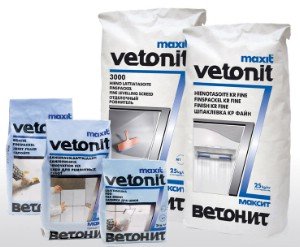 By the way, the Vetonit self-leveling floor is also technically much better than the standard cement screed.
By the way, the Vetonit self-leveling floor is also technically much better than the standard cement screed.
The composition of the mixture necessarily contains the appropriate additives, due to which excellent leveling and rapid hardening of the surface is ensured. Naturally, there are several offers from the Vetonit company.
Their main difference from each other is the speed of hardening and the amount of water that should be used to obtain the solution. All these compounds have one thing in common - they cannot be painted and are not used as a topcoat. Self-leveling mixture for concrete - "Vetonit Vaateri Plus" hardens very quickly, so it is not possible to work alone with it.
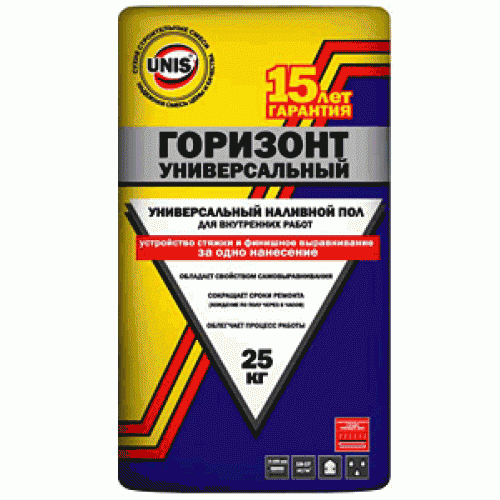 And the mixtures from the company Horizon are thin-layer self-leveling coatings designed for final leveling. They can be used in both public and residential areas, and then lay parquet, laminate, linoleum or ceramic tiles on this screed.
And the mixtures from the company Horizon are thin-layer self-leveling coatings designed for final leveling. They can be used in both public and residential areas, and then lay parquet, laminate, linoleum or ceramic tiles on this screed.
Self-leveling mixtures can be used both in wet and dry rooms, and can also be used as a screed for the "warm floor" system.
The thickness of the applied layer can be from 1 to 10 mm, while walking on the newly created surface is allowed after six hours. The area of use is cement-sand, concrete or gypsum bases. By the way, the floor surface after applying the leveling compounds Horizon can be treated with appropriate paint and varnish compositions to increase decorativeness and thus be used as a finishing surface.
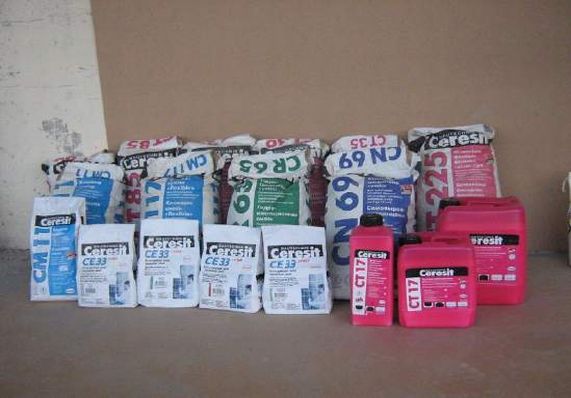 For leveling anhydrite, cement-sand and concrete bases, floor mixes from the Ceresit brand are also intended.
For leveling anhydrite, cement-sand and concrete bases, floor mixes from the Ceresit brand are also intended.
For example, Ceresit Moment Smooth floor is an easy-leveling gypsum-cement composition, which can be applied in a layer from 3 to 80 millimeters.
This mixture is not used as a topcoat for the floor. In addition, it is not recommended as a topcoat either.
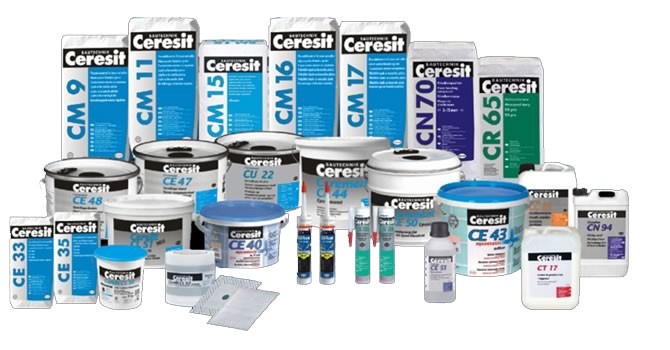 For urgent repair of the screed, you can use Ceresit CN-83 - technological movement on the surface is possible in six hours. Having covered the resulting screed with concrete paints, you will get a decorative surface that is usable without any additional finishing.
For urgent repair of the screed, you can use Ceresit CN-83 - technological movement on the surface is possible in six hours. Having covered the resulting screed with concrete paints, you will get a decorative surface that is usable without any additional finishing.
By the way, the Moment brand floor mixes also belong to the Ceresit brand - for example, the already mentioned Moment Smooth floor composition.
As for materials such as self-leveling mixtures from the manufacturer Volma, they can be used in all rooms without exception without limitation in functionality, with the exception of those in which the surface is in direct contact with water.
For example, the composition of Volma-Levelir-Express can be applied both by machine and by hand, resulting in a strong screed with a thickness of 5 to 100 millimeters. The company's product range also includes the so-called rough leveling devices, the purpose of which is to create coatings in newly erected objects or to repair an existing screed.
Self-leveling floor Bolars are also popular. With their help, you can eliminate the imperfections of the rough surface, as well as get a high-strength and even coating.
As a result of using Bolars mixtures, surfaces are obtained that are distinguished not only by strength, but also by increased heat and noise insulation. At a temperature of 18 ... 20 degrees, such mixtures freeze in a few hours, and after three days you can start laying the topcoat. It should also be noted that almost all of these compositions are self-leveling mixtures for underfloor heating.
Features of the use of flooring with a two-component composition
An innovative coating on the construction market is polymer floors. The high quality of strength and wear resistance allows the use of this coating without an additional finishing layer.
Polymer coating composition:
- Epoxy resin is more often used in non-residential premises, it is convenient to use with the speed of pouring and obtain a floor surface without additional costs.
- Polyurethane is used in private individual construction.
Two-component solutions are distinguished by a smooth surface and the possibility of application without additional labor costs. Consider the benefits:
- The speed of complete drying of the solution is achieved within 2 hours.
- The coating looks impressive and allows you to get a decorative base of the desired look.
- Allows you to apply decorative patterns, wallpaper for the floor and achieve 3D images.
- Due to its high strength and waterproofing properties of the material, it is superior to standard floor mixes.

The insignificant disadvantages of two-component mixtures include:
- Do not use with significant surface differences;
- Quite an expensive level of cost of the resulting surface;
- High consumption rate of about 1.5 kg per sq.m.
Two-component solutions are often used by specialists of the InnovaStroy company when creating decorative floors with graphic images. With a complete catalog of finished projects
can be found on the pages of the site. The effectiveness of obtaining a mirror surface in combination with color patterns and high waterproofing properties allows you to increase the frequency of application of the mixture. Many clients, wishing to obtain a unique, unusual surface, prefer modern 2-component fillings.
7 basic tips for choosing a floor leveling compound:
Before buying a mixture, you need to decide exactly on the purpose of the premises.
If you want to get a warm floor, give preference to gypsum mixtures
Such compositions have higher heat retention rates.
Before using the mixture, it is important to read the instructions, taking into account all the manufacturer's recommendations and properly dilute the composition.
Remember that gypsum mixes do not have waterproofing and do not apply in places accumulation of moisture (bathroom, kitchen, pool).
Practical polyurethane 2-component mixtures are ideal for cottages, apartments and houses.
Install the beacons correctly to obtain a perfectly flat surface.
Do not try to achieve a perfect surface with a thick layer. It is better to apply the technology of stage-by-stage filling with two different mixtures.
Knowing the basics, applications and the technology of pouring the flooring, you can get a high-quality floor yourself. The quality of work can only be assessed under conditions of constant use of the floor.
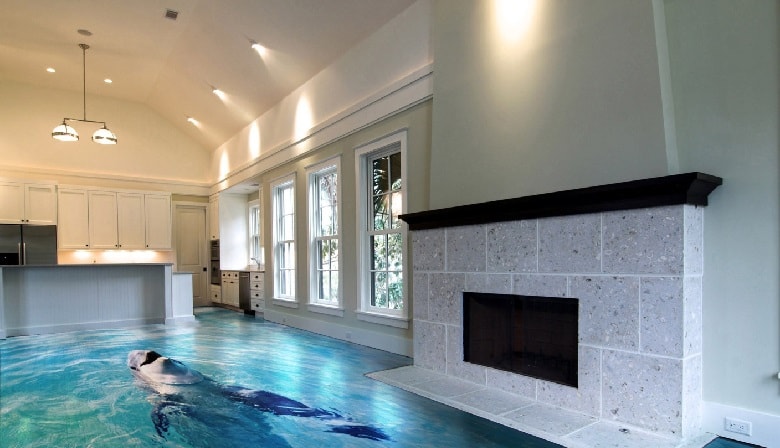
The specialists of the InnovaStroy company develop unique sketches of the floor surface in cottages and private houses. It is quite easy to create a colorful, effective floor using 3D images. At the same time, the warm surface of the floor covering allows not to use additional electric floor heating systems, which significantly saves further maintenance of the house. We recommend that you contact professional craftsmen who know the basics, technology and application of all types of floor mixes. A pleasant and warm floor in the premises of your daily stay is a guarantee of health and comfort for the whole family.
If you make a request on the Internet "level the floor", we will see three different names: leveling, self-leveling floor and self-leveling mixture, not counting the screeds. Let's see how these three names of building mixtures differ or do not differ.
